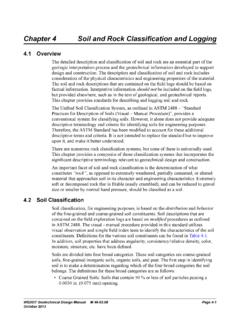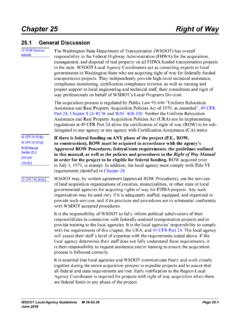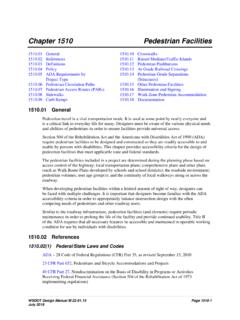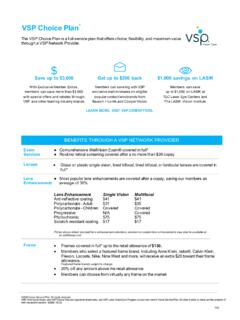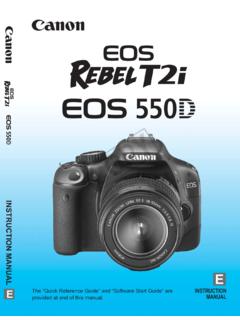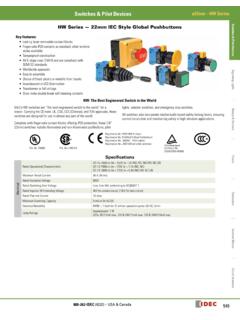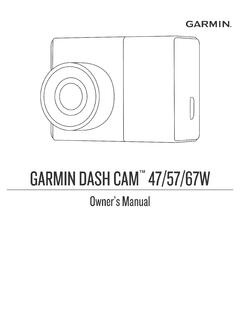Transcription of Chapter 3 Surveying Equipment, Measurements and Errors
1 May 2005 Surveying equipment , Measurements AND Errors 3(i) Chapter 3 Surveying equipment , Measurements and Errors Table of Contents Section Page (1) Personal Use of State Issued (1) General Instrument Care and (1) Operator s (2) Routine Care of (2) Vehicular (2) Casing and (3) (3) Field (4) Major (4) equipment (4) Total (4) Global Positioning System (6) (7) Electronic Distance Measuring Instruments (Total Stations).. (8) Miscellaneous (10) Leveling (12) (16) Level (17) (1) Angular (1) (1) (2) Coordinate (2) Vertical (3) (3) (3) (4) Differential (4) (ii) Surveying equipment , Measurements AND Errors May 2005 Single-Wire (6) Double-Turn Point (6) Three-Wire (7) Trigonometric Vertical (9) Linear measurement with (10) (10) Care and Maintenance of (10) Errors , Corrections and (1) Instrument (1) (1) Plate Bubbles, Bull s Eye Bubble and Optical (1) (2) Personal (2) Error in the measurement of the HI and (2) Setting Up the (2) Setting (3) (4) Measuring (4) (4) Analyzing Field (5) Natural (5) Differential (5) Heat (5) (5) (5) Curvature and (6)
2 Table of Figures and Forms Figure/Form PageForm 3-1 Base Line User Figures & Forms (1) May 2005 Surveying equipment , Measurements AND Errors (1) Chapter 3 Surveying equipment , Measurements and Errors equipment The procurement and maintenance of Surveying equipment , tools and supplies are important parts of the Department s survey effort. Proper care in the use, storage, transportation and adjustment of the equipment is a major factor in the successful completion of a survey. Lack of good maintenance practices can jeopardize the efficiency and accuracy of the survey. This manual addresses the various types of survey equipment used by the Department s construction/survey personnel, the maintenance and care of the equipment and general procedures for surveys using the equipment .
3 The majority of surveys done by and for the department utilize total stations, Global Positioning System (GPS), engineers levels (optical and digital) and data collectors. Appendix A includes sample notes associated with various field surveys. These sample notes may be beneficial in cases where field notes are taken and/or helpful to determine information that should be recorded in the data collector. It is the Engineering Project Manager (EPM) and/or the party chief s responsibility to train all crew members in the proper use of Surveying equipment and the maintenance of all Surveying instruments, tools and supplies. The Photogrammetry & Survey Section or the District land surveyor should be contacted if additional training beyond the instruction provided by the EPM is required. PERSONAL USE OF STATE ISSUED equipment Refer to current management memos and/or MDT policies regarding the use of state issued equipment for personal use.
4 GENERAL INSTRUMENT CARE AND SERVICING Surveying instruments are designed and constructed to provide years of reliable use. Although they are constructed for rugged field conditions, the mechanical components and electronics of precision instruments can be damaged by careless acts or inattention to the procedures for use, care and adjustment of the instruments. (2) Surveying equipment , Measurements AND Errors May 2005 Operator s Manual An operator s manual is furnished with each new instrument. Among other information, the manual contains basic instructions for operation of the instrument and describes recommended servicing and adjusting methods. The manual should be kept with the instrument at all times. Study the manual before using the instrument, particularly before making field adjustments.
5 If the manual is lost, stolen or damaged beyond use, obtain a replacement copy of the manual. Routine Care of equipment Before making the first set-up of the day, visually inspect the instrument for damage. Check the machined surfaces and the polished faces of the lenses and mirrors. Try the clamps and motions for smooth operation (absence of binding or gritty sound). Clean the exterior of the instrument frequently. Any accumulation of dirt and dust can scratch the machined or polished surfaces and cause friction or sticking in the motions. Remove dirt and dust with a clean, soft cloth or with a camel-hair brush. Clean non-optical parts with a soft cloth or clean chamois. Clean the external surfaces of lenses with a fine lens brush and, if necessary, use a dry lens tissue. Do not use silicone-treated tissues because they can damage coated optics.
6 The lens may be moistened before wiping it, but do not use liquids (oil, benzene, etc.) for cleaning . Do not loosen or attempt to clean the internal surfaces of any lens . After an instrument has been used in damp or cold situations, use special precautions to prevent condensation of moisture inside the instrument. If the instrument is used in cold weather, leave it in the carrying case in the vehicle during non-working periods rather than take it into a heated room. If you store the instrument in a heated room overnight, remove it from the carrying case. If the instrument is wet or frost-covered, bring it into a warm, dry room, remove it from its case and leave it at room temperature to dry out. Vehicular Transport Transport and store instruments in positions that are consistent with the carrying case design.
7 For example, total stations should be carried and stored in their correct May 2005 Surveying equipment , Measurements AND Errors (3) position. Many instrument cases indicate the position in which they should be transported. Treat tribrachs, prisms and tripods with care. Carry them in their shipping cases or cushion them with firm polyfoam or excelsior-filled cases to protect them from jolting or vibrating excessively. Casing and Uncasing Before removing an instrument, study the way it is placed and secured in the case. Place it in the same position when you return it to the case. In removing the instrument from the case, carefully grip it with both hands, but do not grip the vertical circle standard or where pressure will be exerted on tubular or circular level vials. Setups Whenever possible, the instrument should be used in areas where operation is not dangerous to the instrument operator or the instrument.
8 Select stable ground for the tripod feet. Do not set an instrument in front of or behind a vehicle or equipment that is likely to move. In cold or hot weather when vehicle climate controls are used, survey instruments should be acclimated to outside conditions for an adequate period of time prior to final setup adjustments. At the survey mark, firmly set the tripod with its legs spread wide. Push along the legs, not vertically downward. Extra precautions should be taken on smooth surfaces. The total station should not be attached to the tripod. Always have the tripod firmly set before removing the instrument from its carrying case. Immediately secure the instrument to the tripod. If a total station is to be used, remove the instrument from the tribrach. Center and level the instrument over the mark using only the tribrach.
9 Then place the total station in the tribrach for final leveling and verification that the instrument is still centered above the mark. Never leave an instrument or its tribrach on the tripod without securing either to the tripod. Moderate pressure on the fastener screw is sufficient. Excessive tightening causes undue pressure on the foot screws and on the tribrach spring plate. Make sure the tribrach clamp is in the lock position. (4) Surveying equipment , Measurements AND Errors May 2005 Field Adjustments Frequently check level vials, optical plummets, tripods, etc. for proper adjustment. In the field, make adjustments only when the instrument results are poor or require excessive manipulation. Instruments should only be checked under favorable conditions.
10 Only the adjustments described in the manual for the instrument should be made in the field or shop. Do not field strip (dismantle) instruments. Major Adjustments When an instrument has been damaged or otherwise requires major adjustments, contact the Construction Bureau. Indicate the type of repairs needed. In the case of total stations, digital levels or optical levels, describe the conditions under which the instrument does not function properly. Indicate if a loaner instrument is required. equipment DESCRIPTIONS Specific Surveying equipment is described below, along with its uses and any special precautions for its care. Total Stations A total station is used for measuring both horizontal and zenith angles as well as slope distances. In addition, they also have features for measurement to points that cannot be directly observed (offset measurement ) and basic Coordinate Geometry (COGO).






